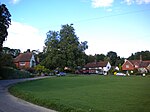Cooksbridge Meadow
Sussex Wildlife Trust

Cooksbridge Meadow is a 9-hectare (22-acre) nature reserve south of Fernhurst in Sussex. It is managed by the Sussex Wildlife Trust.Most of this site is grassland but there is also a narrow strip of woodland and a stream. The meadows are grazed by sheep in order to keep the grass down and ensure a good display of flowers in the spring. Woodland flowers include sanicle, yellow archangel and purslane.There is access by a footpath opposite the Kings Arms public house on the A286 road.
Excerpt from the Wikipedia article Cooksbridge Meadow (License: CC BY-SA 3.0, Authors, Images).Cooksbridge Meadow
Midhurst Road, Chichester
Geographical coordinates (GPS) Address Website Nearby Places Show on map
Geographical coordinates (GPS)
| Latitude | Longitude |
|---|---|
| N 51.035 ° | E -0.725 ° |
Address
Banyan
Midhurst Road
GU27 3HA Chichester
England, United Kingdom
Open on Google Maps





